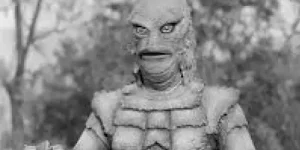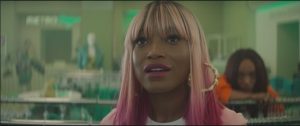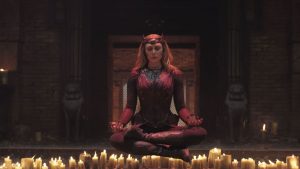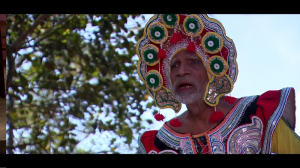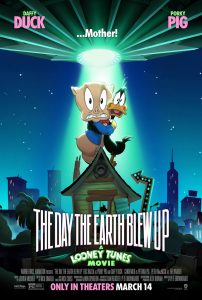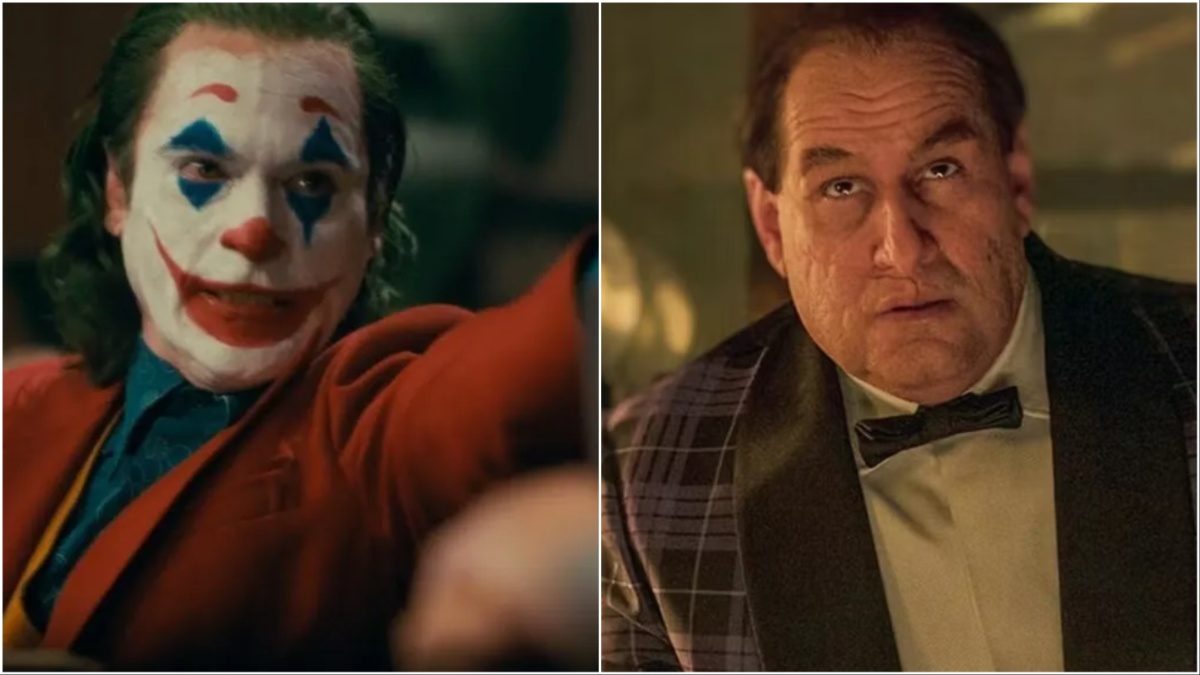
Even from the first film, Joker has only had the thinnest veneer of being a film about the criminal clown who fights Batman. It was, first and foremost, an homage to Martin Scorsese’s films The King of Comedy and Taxi Driver, with some comic book signifiers to guarantee a wider audience and studio funding. So when Joker: Folie à Deux announced that it was going to introduce Joker’s on/off girlfriend, Harley Quinzel (played by Lady Gaga), it should not have been a surprise the character was going to see some reworking.
In an interview with Variety, director Todd Phillips revealed, “The high voice, that accent, the gum-chewing and all that sort of sassy stuff that’s in the comics, we stripped that away. We wanted her to fit into this world of Gotham that we created from the first movie.”
He wasn’t wrong. Lady Gaga’s portrayal of Harley Quinn is a world away from the character as it was originally envisaged, a Saturday morning cartoon character dressed up as a court jester (or harlequin! Pun names exist for a reason!). While Lady Gaga gives a good performance, there is no shortage of criticisms of this version of the character. As our own Rosie Fletcher points out, “Despite Gaga’s best efforts, Lee is barely a character at all with scant screen time and no actual personality of her own. We know nothing about Lee other than that she’s a liar and a fantasist.”
Despite the oh-so-mature pretentions of both Joker films, Phillips’ interpretation of Harley Quinn has less depth than the children’s cartoon she is based on. The Harley Quinn of Batman: The Animated Series started off as a one-note sidekick, evolving to strike out on her own from Joker, building friendships with other villains such as Poison Ivy, and occasionally even finding herself on the side of the good guys. But that animated version of the character is now only one among comics, video games, her own animated series, and even other movies. As she moved into other media, the story of her relationship with the Joker grew deeper, often talking about leaving and trying to grow beyond an abusive relationship.
But by stripping this character back the way that Phillips has, it raises the question of just how much you can strip back a character while still having it be, in any way, meaningfully the same character. Like a tower of Jenga blocks, how much can you take away while still leaving the structure standing?
Harley Quinn
The qualities of the character that Philips wanted to “strip away,” the high voice, the accent, and the sassiness, were introduced by writer Paul Dini based on the actor who would first voice the role, Arleen Sorkin. These qualities, along with the medieval jester costume, would come to define the character and as time went on we would discover she was also a psychologist (originally at Arkham to treat Joker before falling in love with him), and a big fan of giant cartoon mallets.
But to be a comic book character (and it wasn’t long before Harley found her way into comics) is to be constantly reimagined, and Harley has seen a lot of that.
The first, drastic reimagining came with her appearance in the Batman: Arkham Asylum game. For the game, her jester onesie disappeared in favour of a far more grim, gritty, and above all, revealing outfit. It met with a wave of criticism, but still found its way back into comics and quickly became the default Harley outfit—proving the basis of Margot Robbie’s first appearance as Harley in Suicide Squad, as well as the Harley animated series.
But watching Robbie’s performance, while it is most definitely not for children, she is still recognizably the same character that Arleen Sorkin voiced in Batman: The Animated Series. Her outfit is different, with only a vague red and blue colour coding to hark back to that original outfit, and a baseball bat in place of a cartoon mallet, but the bubble gum, the accent, the air of candyfloss ditzy-ness around a core of steely determination is still there. She still has the same drive—mainly a desire to cause chaos that is sometimes channelled into attraction to evil guys who are no good for her.
This is arguably also the primary drive for Philipps’ version of Harley, but while most iterations of Harley are criminals and psychologists in their own right, drawn towards people with as much of or more of a hunger for chaos than her own, this version comes across as little more than a fangirl, and when the target of her fandom doesn’t live up to her ideals, she attempts to Lady Macbeth him into the role as if she’s incapable of filling it herself.
But this is not the only new version of Harley we’ve seen this year. Bruce Timm, who co-created the original Harley for Batman: The Animated Series, has this year launched Batman: The Caped Crusader, an animated series that goes back to Batman’s noir-ish ‘30s Detective Comic roots. This series features its own take on Harley, back in the jester’s costume, with red and black, or red and blue switched for a yellow and black colour scheme, and no Joker in sight.
This Harley is first and foremost a psychologist. The accent is still there, if a good deal more subtle. Rather than harking after her abusive clown boyfriend, this Harley targets the rich, powerful and corrupt, mentally breaking them until they give their fortunes to charity. It is honestly hard not to root for her.
So is this character any more Harley Quinn than Lady Gaga’s fangirl? Any less?
The Joker
Joker’s Arthur Fleck is definitely not the same character that has fought the many iterations of Batman through the years. If there was any doubt before, the film’s shocking if questionable ending settled the case. Phillips himself has come out and said, “The first film is called Joker. It’s not called ‘The Joker,’ it’s called Joker. And the first film under the script always said ‘an origin story.’ Never said THE origin story. It was this idea that maybe this isn’t THE Joker. Maybe this is the inspiration for the Joker. So, in essence at the end of this movie, the thing you’re being left with is ‘Wait, what is that thing happening behind him? Is that the guy?’”
And whatever else you think about that plot twist, there is some wisdom in it. After all, in cinema the character of the Joker has been owned by one man and one man only for the last 12 years. Heath Ledger’s interpretation of the character for The Dark Knight has overshadowed every attempt to realize the character since, from Jared Leto’s too-enthusiastic embrace of method acting to Barry Keoghan’s blurry interrogation room take in The Batman, to Joaquin Phoenix’s own titular sad sack.
So it is hard to remember that at the time, Ledger’s version of the Clown Prince of Crime was a radical departure. Feral, twitchy, dishevelled, this Joker was worlds away from the polished showman of Cesar Romero, Jack Nickelson, or Mark Hamill’s iconic animated take.
This wasn’t a Joker who was sad and angry because the world never appreciated him enough, but he lacked an ingredient that until then was considered crucial—the character’s glee. Ledger’s Joker was funny (a much more essential ingredient future Jokers have forgotten) but it was a grimmer humor where even the darkest interpretations of the character enjoyed their cruelty, Ledger’s Joker seems merely disappointed nobody else gets the joke.
And yet, by cutting away the polish and the more overt showmanship, Nolan and Ledger show us an angle of the character that always existed. The chaos of the character, with his unknown origin story and inconsistent behavior and crimes that appear equal part intricate plan, spontaneous whim, and performance art piece. This Joker doesn’t need an origin story. You get the sense he’s probably the Joker not because of a tragic backstory or a vat of chemicals, but just because he decided to be.
The Penguin
It’s no coincidence that the characters most susceptible to this kind of streamlining, for good or bad, are the villains in Batman’s rogue’s gallery. It is a gallery filled with colourful imagery, potent iconography, and dramatic motivations and origin stories. Which begs the question why so many interpretations are keen to strip away all of that. Catwoman, for instance, is arguably far more interesting as Batman’s cat-themed frenemy than she is as simply a “cat burglar” whose goggles look a bit like eats from the right angle (as in The Dark Knight Rises).
In all honesty, the Penguin stands out as one of the most vanilla in the pack. At first glance he’s basically just a gangster, fatter than most, with a penchant for tuxedos and nautical or bird-themed imagery. From that template we have had Burgess Meredith’s camp, top hatted ‘60s villain, Danny DeVito’s bitter and deformed politician in Batman Returns, and Robin Lord Taylor’s effete yet ruthless momma’s boy in Gotham.
The Arkham games’ interpretation of the character sounds like a Dickensian crime lord, with a glass bottle-bottom gauged into one eye in place of his usual trademark monocle. Batman: The Caped Crusader recently gender-flipped the character, and yet she was still instantly recognizable as the Oswald Cobblepot of all the comics and movies we know, with her cruise boat nightclub and high end evening wear.
By contrast if you took any of the production stills from the Colin Farrell TV show, The Penguin, you could be forgiven if you were told it was a Sopranos reboot. The only two links to the character’s origins, aside from his appearance in The Batman, are that he is a fat man and he has a club foot, which is responsible for his penguin-like waddle. His outfits are decidedly more downmarket than anything even the sewer-dwelling Danny DeVito version would be seen dead in.
Yet there is still a core to the character that persists across all versions, and it’s not just that they have a rotund physique and a prominent nose. In all these characters there is an obsession with class status—either status lost and fought to be regained or status aspired to, and that is what Farrell’s Penguin is all about.
Doctor Who, Sherlock Holmes, Spider-Man and More
It all comes down to “what is important to the character?” “What makes the character them?” and, more often than not, “What does the storyteller actually care about?”
Outside of Gotham City, one of the biggest streamlined reboots was probably the 2005 continuation of Doctor Who. It was a strategic stripping away of the character’s identifiable traits. The TARDIS, the companion, and the sonic screwdriver that allowed you to hop past inconvenient plot points got to stay. But instead of a flamboyant outfit with scarves and frock coats and question markets, the Doctor returned in a leather jacket and a V neck sweater. Instead of the Doctor’s professorial demeanor and received pronunciation, he was talking about chips, pop music, and reality TV in a working class Northern accent.
And it made sense, because it highlighted what the character was for. The Doctor’s an alien, they shouldn’t really have any regard for the class signifiers of a rainy island on a planet that hasn’t even developed antigravity yet. So instead the show focused on the character’s sense of wonder, adventure, and frankly, scariness. It appealed to the same things the character appealed to in 1963, shorn of cultural flags that were already 40 years out of date.
Sherlock Holmes is one of the most reimagined characters in fiction, and has been coded as posh, queer, autistic, an addict, and an action hero at various times for various audiences, but all these interpretations take enough from the original Arthur Conan Doyle stories that as wildly different as they are, they are familiar. Perhaps the best example is Gregory House, a character who is recognizably Sherlock Holmes despite not being called Holmes (House! Get it?). He doesn’t even solve crimes.
And as crucial as some elements are, some do not make the cut. As Moffat pointed out when he brought his version of Dracula to the small screen, with modern audiences you simply can’t get away with giving the Count his canonical moustache.
Ultimately, characters are collections of verbs (one might say that it is what they do that defines them). Harley kicks ass, creates chaos, and has a problematic relationship history. The Joker does a lot of things, but perhaps the most important of those is that he craves Batman’s attention. The Penguin is driven to crime by status anxiety. Sherlock Holmes uses his off-kilter view of human nature to solve mysteries from seemingly minor or unrelated clues.
The thing about these “stripped back” character interpretations, however, is that the bells and whistles you get rid of are expressions of those core motivations and actions you are trying to get to. The silly themed weaponized umbrellas, the tuxedos and top hats, and posh way of speaking, these are all signifiers of what Penguin wants, and their ridiculousness demonstrates how he is failing to achieve them.
By the same token, you can make Harvey Dent a duplicitous lawyer with a scarred face, but the thing that really makes the character interesting and fun is seeing that duality infect everything from his own outfits to his henchmen’s uniforms (and oh, how I wish we could have more themed hench uniforms in Batman movies).
While the trend to strip characters back continues, there is another strong trend toward going even more extra on them. The glut of “multiverse” stories approaches the same question from the opposite direction. How much can we add to, twist, and change these characters and still end up with the same person? If Spider-Man is a Tyrannosaurus Rex, or a Japanese girl in a giant robot, or a noirish detective, how is he still Spider-Man?
Miles Morales is not Peter Parker. And yet beyond the costume and the sticky hands, he’s got all the right verbs—his stories are about someone whose life is split between being an ordinary, awkward but bright kid and a superhero, and both of those lives are defined by a path of failed good intentions that repeatedly and painfully blow up in their faces. As a character Miles is far more like the Peter Parkers we know and love than Arthur Fleck is to any version of the Joker.
For all that this stripping back can reveal, there is something to be said for demonstrating character by going extra.
The post Joker 2: How Much of a Character Can You Strip Away and Still Be Faithful? appeared first on Den of Geek.



